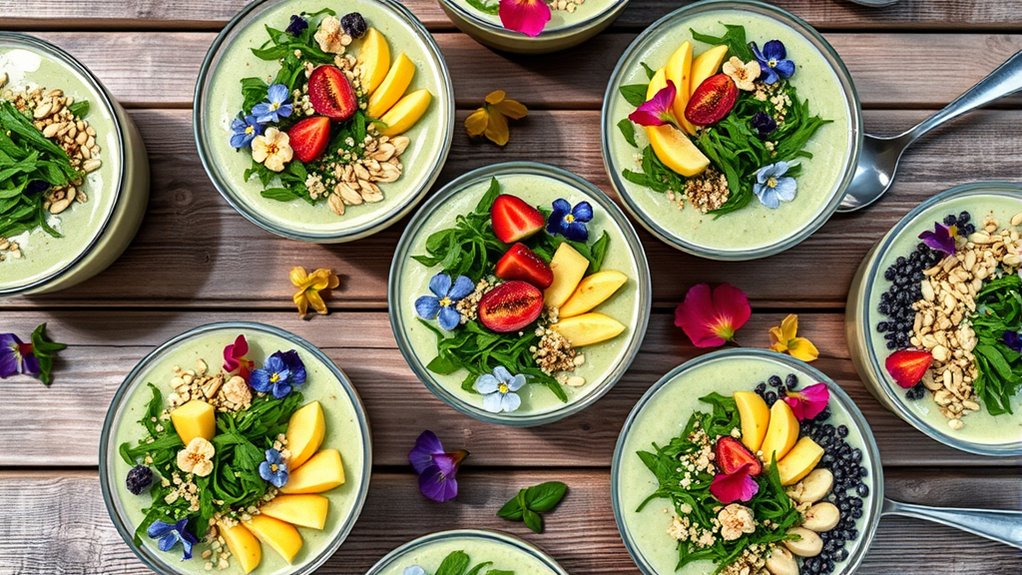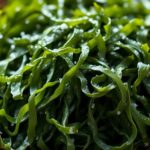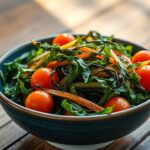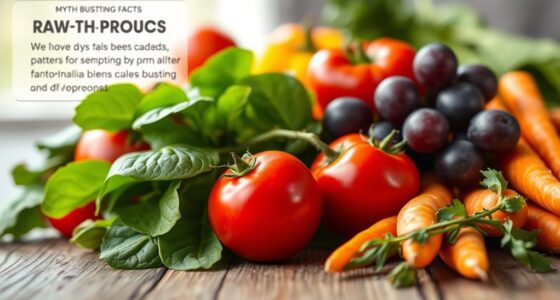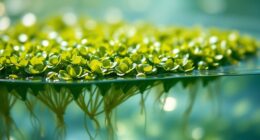You can easily incorporate sea vegetables like nori, kelp, or wakame into your raw smoothie bowls for added nutrition and flavor. Blend small amounts into your base to infuse a subtle umami taste and boost iodine, calcium, and antioxidants. Pair these with vibrant fruits and colorful toppings to create a visually appealing, nutrient-dense meal. Want to discover more creative ideas and benefits? Keep going to uncover the full potential of sea vegetables in your bowls.
Key Takeaways
- Incorporate small amounts of dried or fresh seaweed like nori, kelp, or wakame into the smoothie base for added nutrients.
- Blend sea vegetables thoroughly to provide a subtle umami flavor without affecting texture.
- Pair the savory seaweed flavor with sweet fruits and vibrant toppings for balanced taste and visual appeal.
- Use colorful fruits and toppings such as berries, kiwi, or dragon fruit to create an eye-catching, nutrient-rich presentation.
- Enhance the smoothie bowl’s nutritional profile by combining sea vegetables’ mineral benefits with fresh, whole ingredients.

If you’re looking to boost your smoothie bowls with a nutrient-packed twist, incorporating sea vegetables is a game-changer. These oceanic superfoods are packed with essential vitamins, minerals, and antioxidants, making them a powerful addition to your healthy breakfast. Seaweed nutrition offers a rich source of iodine, calcium, magnesium, and iron, all of which support thyroid function, bone health, and energy levels. Adding sea vegetables to your smoothie bowl not only enhances its nutritional profile but also introduces a unique umami flavor that complements the sweetness of fruits and other ingredients.
Integrating seaweed into your smoothie bowls is surprisingly simple. You can blend small amounts of dried or fresh seaweed, such as nori, kelp, or wakame, directly into the base. Start with a teaspoon or two and adjust according to your taste preference. The seaweed’s subtle briny flavor enriches your smoothie without overpowering it, creating a complex, savory note that elevates the dish. If you’re new to sea vegetables, blending them into your smoothie is a discreet way to enjoy their benefits without their texture being too noticeable.
Blend small amounts of dried or fresh seaweed like nori or kelp into your smoothie base for added flavor and nutrition.
Once the seaweed is incorporated into the smoothie, you can focus on presentation. Colorful toppings aren’t just visually appealing; they also add nutritional diversity. Think vibrant berries, slices of kiwi, dragon fruit, or shredded coconut. These toppings create a striking contrast with the deep green or dark hues of seaweed, making your bowl visually stunning and encouraging you to eat more mindfully. The bright colors also indicate a variety of antioxidants and phytochemicals, boosting your immune system and overall health. Experiment with different combinations to keep things exciting—layer the toppings artfully for a vibrant, eye-catching appearance.
Sea vegetables are versatile, and their inclusion in raw smoothie bowls offers a subtle but powerful way to enhance flavor and nutrition. They blend seamlessly into the base, providing a umami-rich undertone that pairs well with sweet and tart fruits. The addition of colorful toppings not only makes your bowl more appealing but also increases its nutrient density, offering an array of vitamins, antioxidants, and fiber. By combining these elements, you turn a simple smoothie bowl into a nutrient-dense, eye-catching meal that energizes and nourishes your body.
Ultimately, incorporating seaweed nutrition and colorful toppings into your raw smoothie bowls transforms your breakfast into a nourishing, appealing experience. It’s a practical way to enjoy the ocean’s bounty while fueling your day with wholesome ingredients.
Frequently Asked Questions
Are Sea Vegetables Safe for Everyone to Consume Regularly?
Sea vegetables can be a healthy addition to your diet, but they’re not safe for everyone to consume regularly. You should be mindful of nutritional risks like iodine overconsumption, which can affect your thyroid. Also, consider allergy considerations, as some people may be allergic or sensitive. If you have thyroid issues or allergies, consult your healthcare provider before adding sea vegetables often. Moderation helps you enjoy their benefits safely.
Which Sea Vegetables Pair Best With Different Fruit Flavors?
Imagine you’re in a modern-day kitchen, channeling a bit of a Victorian explorer spirit. When choosing sea vegetable varieties for your smoothie bowls, go for nori with berries for a sweet twist, wakame pairs nicely with tropical fruits like mango, and kelp complements citrus flavors. Use flavor pairing tips to balance the ocean’s umami with your favorite fruits, creating a vibrant, nutritious bowl that’s both delicious and visually appealing.
How Do Sea Vegetables Affect the Taste of Smoothie Bowls?
Sea vegetables add a unique umami flavor and depth to your smoothie bowls, enhancing overall taste. Different varieties like nori or kelp bring subtle saltiness and richness, balancing sweetness from fruits. Their natural mineral content also boosts flavor complexity. When you incorporate sea vegetable varieties thoughtfully, you’ll notice a delightful flavor enhancement that makes your smoothie bowls more vibrant and nutritious without overpowering the fruit flavors.
Can Sea Vegetables Be Used as a Protein Source in Bowls?
Yes, sea vegetables can be used as a plant-based protein source in bowls. They’re rich in sea vegetables nutrition, providing essential minerals and vitamins, and contain natural plant-based proteins that boost the protein content. Adding them to your smoothie bowls not only enhances flavor and texture but also offers a healthy, sustainable, and nutrient-dense alternative to traditional protein sources. You’ll enjoy a delicious, nourishing meal with sea vegetables.
What Are the Best Storage Methods for Sea Vegetables Used in Smoothies?
To keep your sea vegetables fresh, think of storing them as a gentle dance of preservation. Use dehydration techniques carefully to remove excess moisture, then refrigerate them in airtight containers to maintain their liveliness. Follow refrigeration tips like keeping them submerged in a bit of water or sealed in vacuum packs for longer shelf life. This way, your sea vegetables stay flavorful and nutritious, ready to elevate your smoothie bowls whenever you desire.
Conclusion
Incorporating sea vegetables into your raw smoothie bowls not only boosts flavor but also packs a nutritional punch. Did you know that sea vegetables contain up to 20 times more minerals than land vegetables? By adding these ocean treasures, you’re enhancing your health and supporting sustainable eating. So, next time you blend your bowl, consider including sea vegetables—you’ll enjoy vibrant taste and incredible benefits all in one delicious, colorful package.
Ilana has been a vegan for over 10 years. She originally made the switch for health reasons, but soon found herself becoming more and more passionate about the ethical and environmental implications of a vegan lifestyle. Ilana is the author of The Graceful Kitchen, a blog all about veganism. She loves to cook up delicious and nutritious vegan meals, and share her recipes with others who are interested in leading a cruelty-free life. Ilana is also a strong advocate for using whole foods as the foundation of a healthy diet, and believes that going vegan is one of the best ways to achieve this.
